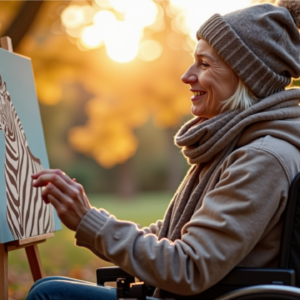 Embrace Wellness Strategies: Alternative Therapies for EDS
Embrace Wellness Strategies: Alternative Therapies for EDS
Managing Ehlers-Danlos Syndrome (EDS) involves more than just traditional medical treatments—it’s about finding a balance that supports your unique body. For many people living with EDS, alternative wellness strategies offer valuable support alongside traditional medical care. Approaches like acupuncture, myofascial release, gentle yoga, breathwork, craniosacral therapy, or low-impact movement can help manage chronic pain, calm the nervous system, and improve daily function. While these methods aren’t cures, they can fill critical gaps where conventional medicine often falls short—especially in reducing pain flares, improving sleep, and promoting emotional well-being. The key is finding what works for your unique body and integrating it into a balanced, sustainable care plan.
Christie Cox, in her book Holding It All Together When You’re Hypermobile, offers a treasure trove of wellness strategies and alternative therapies designed to help you live your best life with EDS. Here’s a sneak peek into her full physical, mental, and social health approach. She uses humor to refer to building your own toolbox like getting a pupu platter at a Chinese restaurant where you get to try a few different things until you find what you like best.
Alternative Therapies that Make a Difference
- Mindfulness and Meditation
Think of mindfulness as your personal mental and autonomic regulation toolkit. Simple practices like meditation or deep breathing can dial down stress and pain, which are often uninvited guests in the lives of those with EDS.
- Acupuncture:
Tiny needles, big relief? Acupuncture has potential in easing chronic pain and boosting energy flow. This ancient therapy is a natural way to help manage the discomfort that comes with EDS.
- Massage Therapy:
Massage isn’t just about relaxation—it’s about chronic muscle spasms and guarding relief. But when you have EDS, you need a therapist who gets it. The right hands can ease muscle tension and improve circulation without risking harm.
- Braces, Supports and Fascia Release Tools:
Braces and posture supports can provide crucial stability to joints that are prone to subluxations or dislocations, allowing better engagement in daily activities with more confidence and less pain. Fascia-releasing tools, such as foam rollers and massage balls, help alleviate muscle tension and improve flexibility by targeting the connective tissues that often become tight and painful due to the body’s compensatory mechanisms.
Nourish Your Body
- Anti-Inflammatory Diet:
Food as medicine? Absolutely. An anti-inflammatory diet packed with omega-3s, antioxidants, and essential nutrients can help keep your joints happier and your inflammation in check. Consider eliminating gluten completely from your diet and see if you feel better in 3-6 months.
- Smart Supplementation:
Supplements like vitamin D, zinc, and magnesium might give your connective tissues a little extra support. Just make sure to chat with your healthcare provider before adding anything new to your regimen.
Prioritizing Self-Care: Your Secret Weapon
- Aromatherapy:
Essential oils aren’t just about pretty smells—they’re about feeling better. Whether you diffuse them, add them to your bath, or include them in a massage, oils like lavender and eucalyptus can offer a calming, pain-relieving boost.
- Sleep Hygiene:
Quality sleep isn’t a luxury; it’s a necessity. Cox advises setting up your sleep environment and routine to help you get the restorative rest your body needs regularly to handle EDS.
- Emotional and Mental Health Monitoring and Wellness:
Living with EDS isn’t just a physical challenge; it’s an emotional one too. Cox suggests finding support through therapy, connecting with others who understand your journey, or diving into creative pursuits to keep your spirit resilient at a bare minimum.
Pain Relief as a Wellness Key Strategy
Cox highlights the importance of prioritizing chronic pain management as a great first step. Living with relentless pain can drain your energy, disrupt your life, and mess with your head. That’s why you need a no-nonsense, multi-pronged strategy to keep pain in check. Think targeted physical therapy to stabilize those rebellious joints, mindfulness to keep your mind from spiraling, and the right mix of meds to take the edge off. Don’t let the pain run the show—get ahead of it with smart, aggressive management techniques that put you back in control.
Heat and Cold Therapy
- Simple yet effective, applying heat or cold to painful areas can provide immediate relief. Heat relaxes tight muscles, while cold reduces inflammation and numbs acute pain.
Pain Tracking
- Cox advises keeping a pain journal or using an app to track triggers, patterns, and the effectiveness of different treatments. This helps in identifying what works best and in communicating more effectively with healthcare providers.
Safe Medication Management
- While medication isn’t the sole solution, Cox acknowledges its role in a comprehensive pain management plan. She recommends working closely with a doctor to find the right balance and avoid over-reliance on painkillers due to the negative consequences, like addiction.
Self-Compassion and Pacing
- Learning to pace activities and really learning and practicing self-compassion are crucial. Overdoing it can lead to flare-ups, so it’s important to listen to your body and rest when needed, without guilt.
In Holding It All Together When You’re Hypermobile, Christie Cox doesn’t just offer advice—she shares a lifeline. Her approach to wellness is all about finding what works for your unique body, blending traditional care with alternative therapies that truly make a difference. Remember, your wellness journey is personal, and these strategies are here to help you navigate it with confidence. As always, consult with your healthcare provider to tailor these practices to your needs.
 Embrace Wellness Strategies: Alternative Therapies for EDS
Embrace Wellness Strategies: Alternative Therapies for EDS